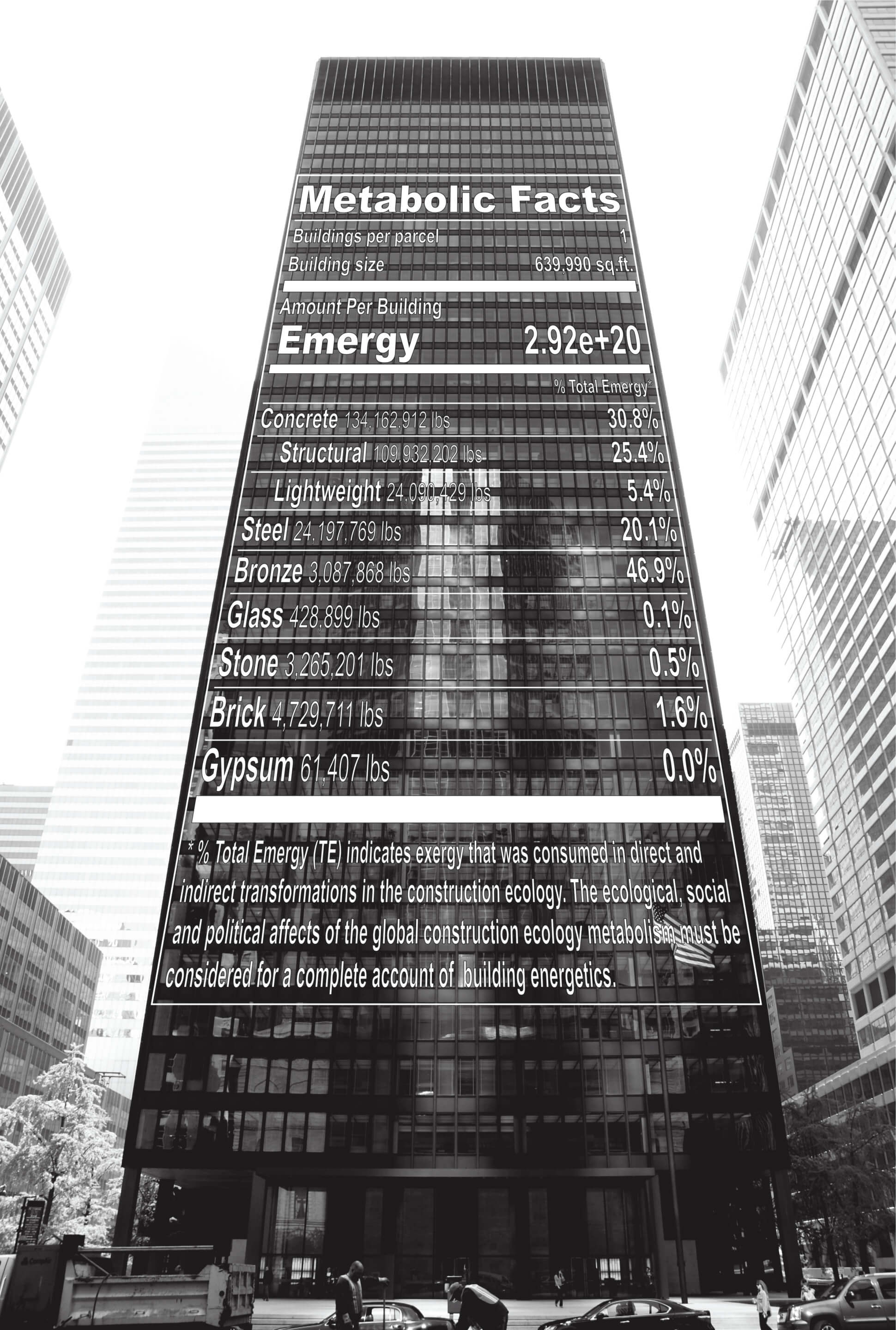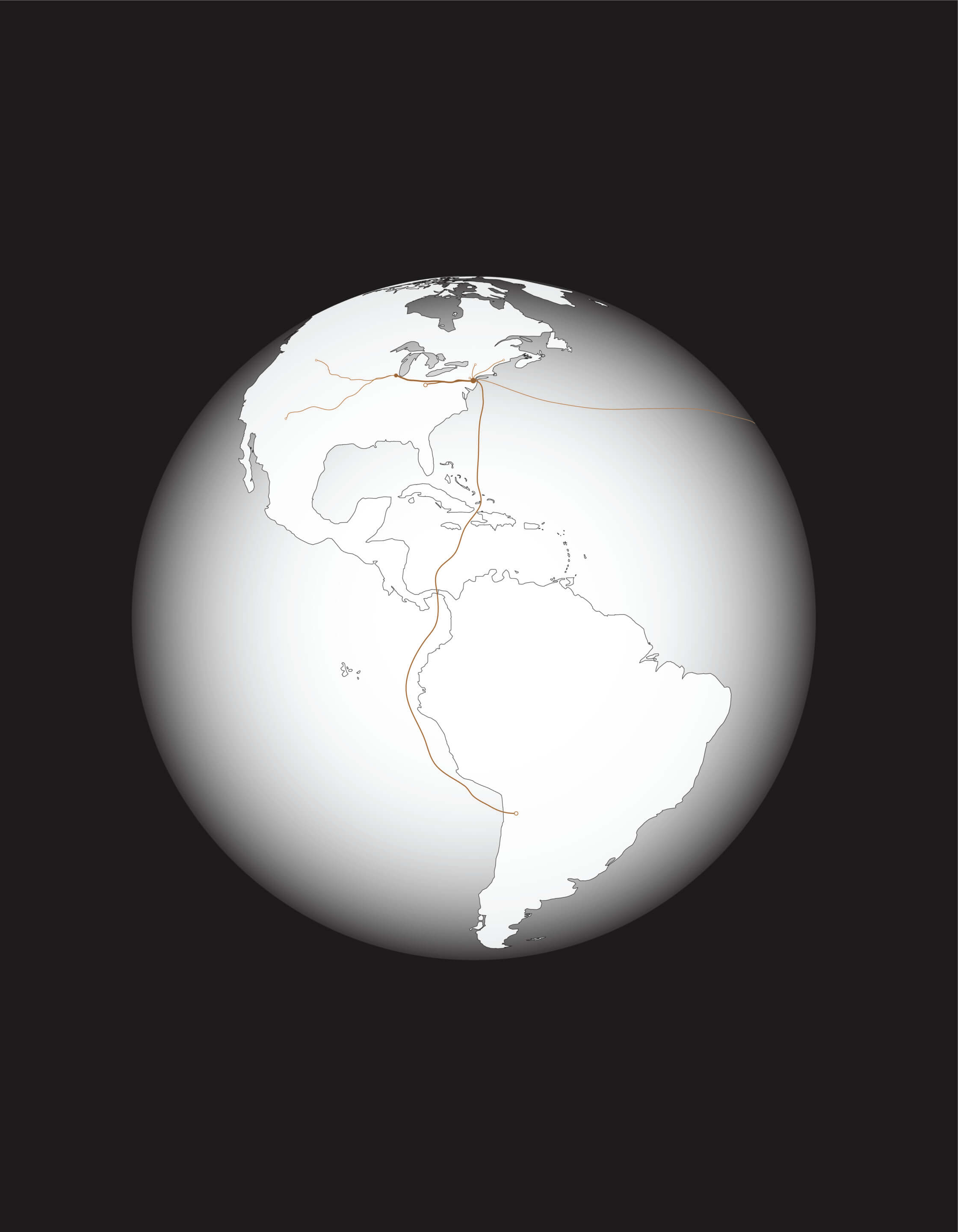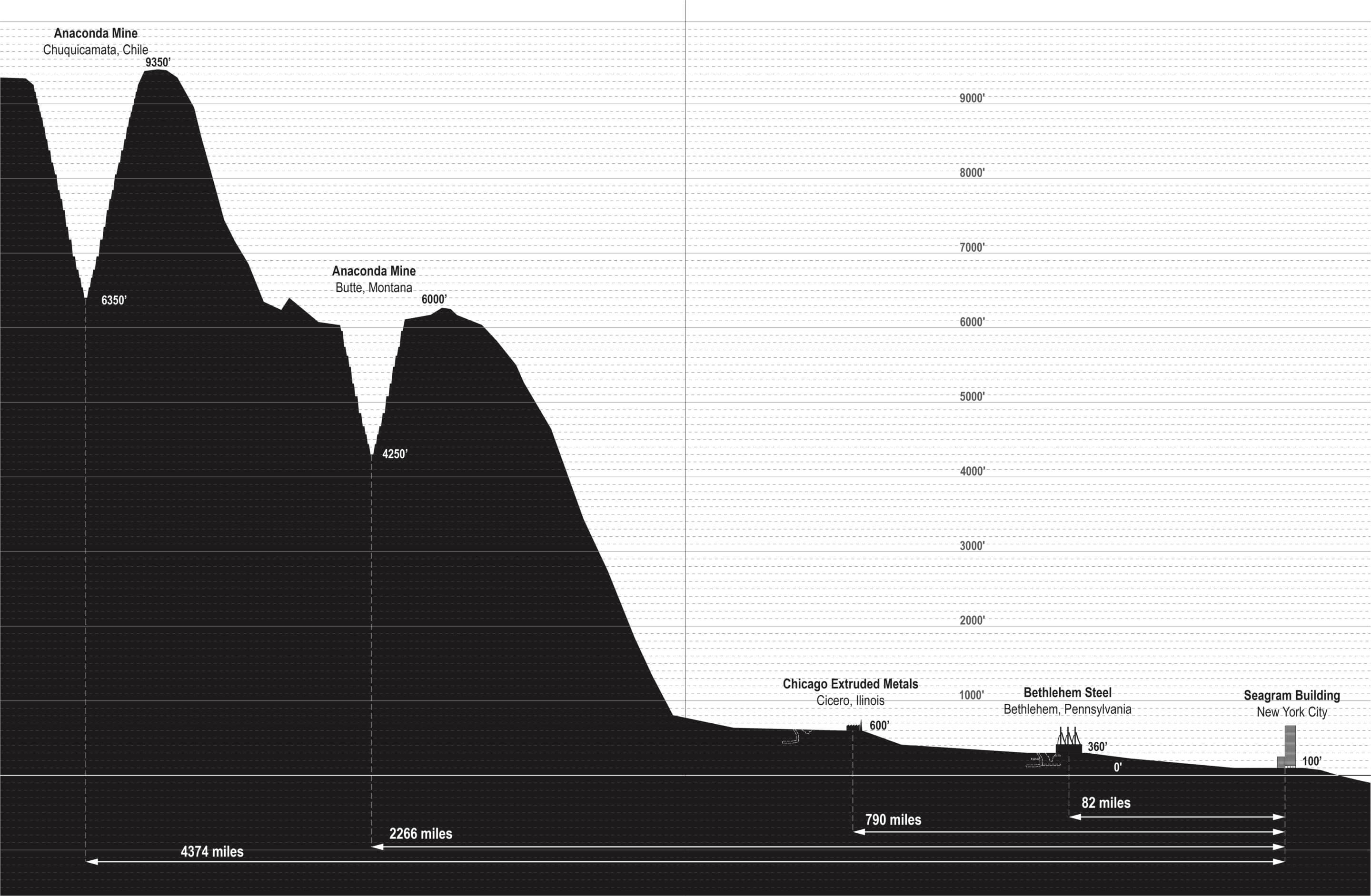Unless: The Seagram Building Construction Ecology
Kiel Moe
Actar Publishers
MSRP: $35
It is September 1609, and Henry Hudson is at the entrance to Upper New York Bay. Although he is familiar with maps and can instruct his crew on how to read them, his most important reference is a book called the Sailing Directions. A cross between an almanac and a geographical treatise, the Directions was written in the 14th century by Ívar Bårdarson, a Norwegian priest who built one of the earliest settlements in Greenland. The Sailing Directions covers a variety of topics, all related to navigating and mapping the northern latitudes, all concerned with the day-to-day business of exploration and discovery. Parts of the book even give a detailed account of what to do should one encounter a new land. Indeed, Bårdarson’s instructions are almost comically specific: Captains are to “send those on land that will show themselves diligent writers, and that they carry themselves so, that they may learn the State of the Country. They shall take with them two Boats and Eight Oars, and take Tinder-Boxes for fire if there be no Habitation. Also set up Crosses of Wood or Stone, if need be.”
Hudson complies. Aboard his ship are none of the cuirassed soldiers bearing harquebuses or lances, broadswords or flintlocks, whom we have come to expect as the shock troops of settler colonialism. Instead, there are writers and builders. These are the first people to claim the Lenape land in this part of the world as “New Amsterdam,” and they are here to assess and take stock of the natural inventory, so to speak.

A latter-day concern with environmental stocktaking is at the heart of Kiel Moe’s latest book, Unless: The Seagram Building Construction Ecology. Moe, a designer and educator who has written several books about environmental systems in architecture, considers the issues of material and energy exchanges implicit in the design and construction of Mies van der Rohe, Philip Johnson, and Phyllis Lambert’s indisputably iconic Seagram Building (1956–1958). A key concept here is “construction ecology,” which Moe describes as “the web of corporeal and incorporeal relations that presuppose building.” Unless identifies and maps out this web, revealing to readers how a singular modernist building was not simply the result of singular design talents but rather physical, economic, and environmental processes spanning different times and multiple geographies. This is no ordinary account of the Seagram Building.
Be that as it may, Unless expands on previous Seagram literature, from Lambert’s searching and analytical Building Seagram (2013) and her sweeping edited volume Mies in America (2001) to the eclectic and interpretive The Presence of Mies (1994), edited by the late Detlef Mertins—an impressive body of work, to be sure, one signaling allegiances to art and architectural history with ease and panache. Moe’s account operates within a different register, however. This is evident in his careful and decisive use of terms like “construction ecology.” Another is “terrestrial activity,” which Moe uses to characterize how the material and energy exchanges outside and away from the Seagram Building’s site at 375 Park Avenue all operate within a prescribed, shallow depth along the earth’s crust. Put another way, design is terraforming, an “Act of Earth” (to quote Thomas Pynchon’s 1997 novel, Mason & Dixon) marked by the extraction, consumption, and alteration of natural resources to make architecture.
Such “terrestrial activity” does not happen only at the moment of a building’s conception, however. For Moe, it is a process that occurs over many, many years. He illustrates this point through a technique he explored previously in Empire, State & Building (2017), which in turn owed a debt to Eric Sanderson’s Mannahatta: A Natural History of New York City (2009). (Sanderson, it should be mentioned, also begins his book with an account of Hudson’s arrival at Mannahatta, the “Island of Many Hills.”) Superimposing photographs, fire insurance maps, and other ephemera, Moe creates a dense tableau depicting the different kinds of terrestrial activity that occurred on, and preceded the existence of, Seagram’s midtown Manhattan block. His analysis begins with maps that describe the original plats that eventually became 375 Park Avenue, a rich site that was home to the Steinway Piano Forte factory from 1857 to 1910 and the Montana Hotel from 1913 to 1955 and razed in 1956 to allow construction of Mies and company’s great tower. Supplemented by measured drawings and diagrams, Moe’s site analysis provides important data about the materials and energy consumed in the creation of this building. One of the most spectacular is a scale diagram showing the Seagram Building’s height in relation to the sizable mounds of resources required for its construction. It is an image that places Seagram in an urgent new context. And in the end, readers will discover that this landmark building is more than just one of the most expensive architectural projects of its era—it is a building whose expenses were underwritten at a massive geographical and temporal scale.

Yet there are instances where Moe’s approach seems overly familiar. His investigation of land use patterns and site histories is reminiscent of ecological historian William Cronon’s groundbreaking Nature’s Metropolis: Chicago and the Great West (1991), a study that relies on central place theory and regional planning approaches to investigate how resource allocation, infrastructural developments, and the movement of capital in the 19th century led to the creation of the Midwest metropolis. Those more attuned to art criticism will recognize in Moe’s analysis some of artist Robert Irwin’s site taxonomies that contemplate the relationship between a work of art and its surrounding environment. But with Unless, Moe aims for something more expansive. This is clear from the onset, when he claims that, “given the paucity of modern and contemporary theoretical engagement with architecture’s contingencies, architects today need novel theoretical frameworks from outside architecture to properly frame and describe terrestrial activity.” Here, as in Empire, State & Building, Moe draws heavily from the work of sociologists such as Bruno Latour and Albena Yaneva, as well as a host of critical geographers, ecologists, and political economists. And yet the most enterprising readers may notice that he does not mention other contemporary scholars like Paul Edwards, Timothy Morton, or Jane Bennett, whose important work on the very issues of scale and ecology that drive Unless could comprise their own “novel theoretical framework.” These omissions appear strategic, however, especially when one considers how Moe intends to introduce architects and designers to a less familiar constellation of theorists and writers.
And yet, Unless is at its best when it is entirely and unapologetically conventional. This is evident particularly in the book’s organization. The last chapters are arranged roughly according to those materials (concrete, steel, marble, travertine, brass, bronze, and glass) that gave the Seagram Building its singular form. Moe demonstrates how each of these materials came at great environmental and social costs. Concrete poured by the Connecticut contractor Pavarini Construction; glass manufactured at the Franklin Glass Company kilns in Pennsylvania; marble quarried in Vermont; and metals mined in Chile and milled in Chicago: all suggest that the Seagram Building is more than a terrestrial building—it is a hemispheric project.

Unless certainly makes for a unique reading experience. From the manifestolike introductory sequence of images to the compact and satisfying conclusion, the canonical Seagram Building feels revived, injected with some newfound significance. There is nary a mention of the various singular figures associated with the building’s design and construction, a decision that gives free rein to Moe’s material and ecological methods. One of these, perhaps already familiar to readers, diagrams the building’s “Metabolic Facts” with a label that riffs on the familiar “Nutrition Facts” found on food packaging. It is certainly a gimmicky image, one that may inspire an eye roll or two. However, it does capture an essential point of Moe’s book: that new techniques and conventions are needed to communicate the amount of energy consumed during a building’s construction. Moe introduces the reader to the concept of “emergy,” a term used by the late ecologist Howard T. Odum in measuring the amount of energy depleted in ecosystems. And yet this is a book that is unmistakably and decisively about a singular building. This is evident in its graphic design. The cover sports the Seagram Building’s familiar and iconic vertical bronze mullions and horizontal Muntz metal spandrels, giving the book a recognizable form. The endpapers are even “bronzed” in the same shade as the curtain wall. Holding Unless, the synecdochic relationship between book and building becomes clear.
Moe’s writing is pithy and clear for the most part, albeit occasionally bogged down by his overciting secondary sources—like the ghost in Shakespeare’s Hamlet, Bruno Latour appears and reappears, announcing himself as if begging to be remembered. Nevertheless, this is only evidence of Moe’s diligence. Taking into account his desire to introduce architects to new, otherwise unfamiliar books and authors, some analytical and narrative drift is to be expected, and there is no doubt that Unless will resonate with architectural audiences wanting to know about the larger social, material, and analytical contexts for the Seagram Building.

On the subject of diligence, we might look to the literary historian Wayne Franklin, whose 1979 book, Discoverers, Explorers, Settlers: The Diligent Writers of Early America, also returns us to Hudson and the Sailing Directions. Hudson and his ilk, Franklin writes, were both dedicated observers and fastidious chroniclers. In catalogs, field books, and travel accounts, their words gave shape to this terrain as they narrated their encounters with the environments, ecologies, and peoples they would come to conquer and decimate. In other words, they described terrestrial activity. And some 233 years later, throughout October and November 1842, a young Karl Marx grappled with similar issues of resource extraction and terrestrial activity. It was for an essay—one of Marx’s first—called “Debates on the Law of Thefts of Wood.” At issue was a Prussian law that levied severe punishment for stealing wood, a criminal offense that Marx viewed in terms of resource allocation and commodity exchange. At one point, he writes, “In order to appropriate growing timber, it has to be forcibly separated from its organic association. Since this is an obvious outrage against the tree, it is therefore an obvious outrage against the owner of the tree.” Marx, a diligent writer himself, wondered about the value of wanton destruction of natural resources in service of other institutions. “Forcible separation” is a loaded term, and yet it captures something evident throughout the pages of Unless: The Seagram Building Construction Ecology. As much as architecture and building are interfaces between nature and society, they are also the very instruments responsible for the “forcible separation” that Marx bemoans.
And yet there may be another meaning for “forcible separation” at play, one that suggests that the object of architectural criticism is to remove the building from its multiple contexts. Unless comes at us fully formed, but oddly devoid of any accounts of specific land use planning and economic maneuverings that also inform the Seagram Building’s construction ecology. Much remains to be written about the various policies that encouraged the construction industry’s patterns of energy consumption in late-1950s New York. Fortunately, Moe’s book appears at a time when writers, critics, and historians are more invested than ever in examining a building’s site as more than a physical artifact—as a nexus of different social, economic, and economic processes. For example, Timothy Hyde, a historian and educator at MIT, recently observed that a building site is “an instrument of social production, of cultural symbolism, of economic valuation, of laws and techniques, tools and bodies.” And for Mimi Zeiger and Iker Gil, co-curators for the latest iteration of Exhibit Columbus, the particular brand of eclectic midcentury modernism that put Columbus, Indiana, on the map is part of the larger history of the Mississippi River watershed region. Unless adds a decidedly materials-oriented slant to such discussions, welcome and necessary, and unabashedly of the moment.
Enrique Ramirez is a writer and historian of art and architecture. He teaches at the Yale School of Art.
AN uses affiliate links. If you purchase something through one of the above links, we may receive a commission.











